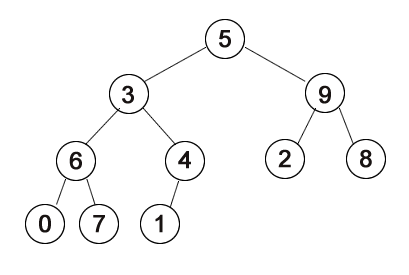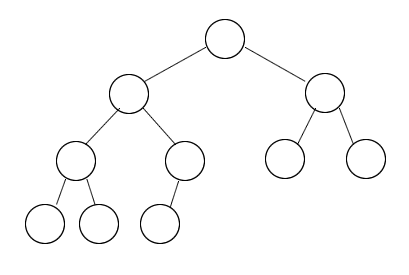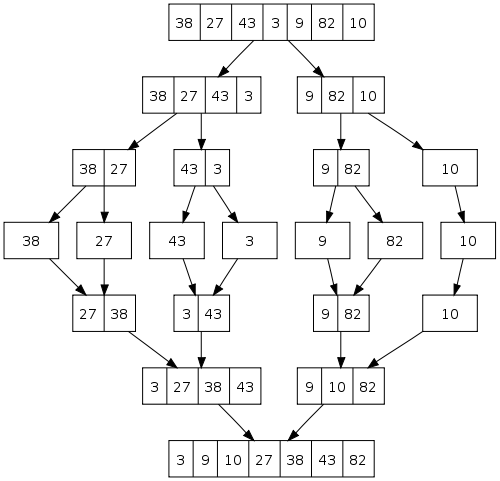A. What will nums look like after two passes of bubble sort?
initially:
AP Computer Science Sorting Test
0. (0 points) NAME________________________________________ PERIOD_________
INSTRUCTIONS
1. (5 points in three parts) Consider the following sorting method:
public static void mystery(int[] a) {
for (int i = 1; i < a.length; i++) {
int j = i;
int current = a[i];
while (j > 0 && current < a[j-1]) {
a[j] = a[j-1];
j--;
}
a[j] = current;
}
}
1A. (1 point) What is the name of this sorting method? (Circle the correct answer.)
Bubble Sort Insertion Sort Selection Sort Heap Sort Quick Sort Merge Sort
1B. (3 points; 1 for order of growth, 2 points for explanation) What is the order of growth of this sorting method? Explain why. (Let n be the number of elements in the array for the purpose of your explanation.)
1C. (1 point) Consider the line of code:
while (j > 0 && a[j-1] > a[j])
Why was it written this way instead of the below line of code?
while (a[j-1] > a[j] && j > 0)
| Elements (n) | Approximate Sort Time (ms) |
| 1000 | 40000 |
| 2000 | 160000 |
| 3000 | 360000 |
| Elements (n) | Approximate Sort Time (ms) |
| 1000 | 1000 |
| 2000 | 2200 |
| 4000 | 4800 |
One of these tables is the result of quick sort, the other is a result of insertion sort.
2A. (3 points) Which table could represent the behavior of quick sort? Which one is insertion sort? Explain using orders of growth.
2B. (2 points) A reasonable function for describing the below table is time = 5nlogn + 4000.
| Elements (n) | Approximate Sort Time (ms) |
| 1000 | 54000 |
| 2000 | 114000 |
| 3000 | 184000 |
Write mathematical functions of the form time = f(n) for the sorts in TABLE 1 and TABLE 2.
3. (5 points)
Given:
int[] nums = {5, 3, 9, 6, 4, 2, 8, 0, 7, 1};
For all problems, assume that the sorts will be in ascending order (i.e., smallest to biggest).
A. What will nums look like after two passes of bubble sort?
initially: ![]()
after pass 1: ![]()
after pass 2: ![]()
B. What will nums look like after two passes of selection sort?
initially: ![]()
after pass 1: ![]()
after pass 2: ![]()
C. What would nums look like if, as seen in class, it were built into a maxheap to prepare a heap sort?
BEFORE BUILDING HEAP AFTER HEAP BUILT


4. (5 points) Write mergesort in Java for ArrayList<Comparable> by filling in the blanks. To assist you, mergesort as fully written in Scheme is given to you. So is a substantial portion of the ArrayList abstraction. A diagram of how mergesort works is shown below.

Mergesort works as follows (from Wikipedia page on Mergesort):
Here is the mergesort method. You will need to write left, right, and merge to make it work.
public static ArrayList<Comparable> mergesort(ArrayList<Comparable> alist) {
if (alist.size() < 2)
return alist;
else {
return merge(mergesort(leftHalf(alist)), mergesort(rightHalf(alist)));
}
}
4A. (1 point) Write left, which takes an ArrayList<Comparable> as input and returns an ArrayList<Comparable> that contains the first half of the input. If the number of elements in the input list is odd, then the middle element should be included in left.
private static ArrayList<Comparable> leftHalf(ArrayList<Comparable> alist) {
ArrayList<Comparable> tmp = new ArrayList<Comparable>(); // Empty ArrayList
int numElements = (int) Math.ceil(alist.size() / 2.0); // Math.ceil rounds up
for (int i = 0; i < numElements; i++) {
tmp.add(________________________________);
}
return tmp;
}
4B. (1 point) Write right, which takes an ArrayList<Comparable> as input and returns an ArrayList<Comparable> that contains the second half of the input. If the number of elements in the input list is odd, then the middle element should NOT be included in right.
private static ArrayList<Comparable> rightHalf(ArrayList<Comparable> alist) {
int index = (int) Math.ceil(alist.size() / 2.0);
int numElements = alist.size() / 2;
ArrayList<Comparable> tmp = new ArrayList<Comparable>();
for (int i = 0; i < numElements; i++) {
tmp.add(________________________________);
}
return tmp;
}
4C. (3 points) Write merge which takes two ArrayList<Comparable>s in ascending order (as determined by Comparable) as its inputs and returns an ArrayList<Comparable> containing the elements of both inputs in ascending order.
private static ArrayList<Comparable> merge(ArrayList<Comparable> alist1, ArrayList<Comparable> alist2) {
ArrayList<Comparable> tmp = new ArrayList<Comparable>();
while (alist1.size() > 0 && alist2.size() > 0) {
if (________________________________________________________________) < 0) {
tmp.add(________________________________);
} else {
tmp.add(________________________________);
}
}
while (alist1.size() > 0)
tmp.add(________________________________);
while (alist2.size() > 0)
tmp.add(________________________________);
return tmp;
}